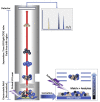Current status of MALDI-TOF mass spectrometry in clinical microbiology
- PMID: 30987712
- PMCID: PMC9296205
- DOI: 10.1016/j.jfda.2019.01.001
Current status of MALDI-TOF mass spectrometry in clinical microbiology
Abstract
Mass spectrometry (MS) is a type of analysis used to determine what molecules make up a sample, based on the mass spectrum that are created by the ions. Mass spectrometers are able to perform traditional target analyte identification and quantitation; however, they may also be used within a clinical setting for the rapid identification of bacteria. The causative agent in sepsis is changed over time, and clinical decisions affecting the management of infections are often based on the outcomes of bacterial identification. Therefore, it is essential that such identifications are performed quickly and interpreted correctly. Matrix-assisted laser desorption/ionization-time of flight (MALDI-TOF) mass spectrometer is one of the most popular MS instruments used in biology, due to its rapid and precise identification of genus and species of an extensive range of Gram-negative and -positive bacteria. Microorganism identification by Mass spectrometry is based on identifying a characteristic spectrum of each species and then matched with a large database within the instrument. The present review gives a contemporary perspective on the challenges and opportunities for bacterial identification as well as a written report of how technological innovation has advanced MS. Future clinical applications will also be addressed, particularly the use of MALDI-TOF MS in the field of microbiology for the identification and the analysis of antibiotic resistance.
Keywords: Antibiotic susceptibility testing; MALDI-TOF MS; Mass spectrometry; Microbiology; Microorganism identification.
Copyright © 2019. Published by Elsevier Taiwan LLC.
Figures


Similar articles
-
Identification of pathogens from blood culture bottles in spiked and clinical samples using matrix-assisted laser desorption ionization time-of-flight mass-spectrometry analysis.BMC Res Notes. 2014 Jun 27;7:405. doi: 10.1186/1756-0500-7-405. BMC Res Notes. 2014. PMID: 24972877 Free PMC article.
-
Direct bacterial identification from positive blood cultures using matrix-assisted laser desorption/ionization time-of-flight (MALDI-TOF) mass spectrometry: A systematic review and meta-analysis.Enferm Infecc Microbiol Clin (Engl Ed). 2018 Oct;36(8):484-492. doi: 10.1016/j.eimc.2017.08.012. Epub 2017 Oct 27. Enferm Infecc Microbiol Clin (Engl Ed). 2018. PMID: 29110928 English, Spanish.
-
Bacterial rapid identification with matrix assisted laser desorption/ionization time-of-flight mass spectrometry: development of an 'in-house method' and comparison with Bruker Sepsityper(®) kit.Acta Clin Belg. 2015 Oct;70(5):325-30. doi: 10.1179/2295333715Y.0000000026. Epub 2015 May 6. Acta Clin Belg. 2015. PMID: 25946409
-
Matrix-assisted laser desorption/ionization time-of-flight mass spectrometry (MALDI-TOF) directly from positive blood culture flasks allows rapid identification of bloodstream infections in immunosuppressed hosts.Transpl Infect Dis. 2015 Jun;17(3):481-7. doi: 10.1111/tid.12373. Epub 2015 May 19. Transpl Infect Dis. 2015. PMID: 25704776
-
Matrix assisted laser desorption time of flight mass spectrometry (MALDI-TOF MS) in clinical microbiology.J Microbiol Methods. 2017 Jul;138:20-29. doi: 10.1016/j.mimet.2016.09.003. Epub 2016 Sep 6. J Microbiol Methods. 2017. PMID: 27613479 Review.
Cited by
-
How MALDI-TOF Mass Spectrometry Technology Contributes to Microbial Infection Control in Healthcare Settings.Vaccines (Basel). 2022 Nov 8;10(11):1881. doi: 10.3390/vaccines10111881. Vaccines (Basel). 2022. PMID: 36366389 Free PMC article. Review.
-
Ceftolozane/Tazobactam and Ceftazidime/Avibactam for Multidrug-Resistant Gram-Negative Infections in Immunocompetent Patients: A Single-Center Retrospective Study.Antibiotics (Basel). 2020 Sep 24;9(10):640. doi: 10.3390/antibiotics9100640. Antibiotics (Basel). 2020. PMID: 32987821 Free PMC article.
-
The influence of growth time on the identification of Bartonella henselae strains by MALDI-TOF mass spectrometry.Rev Inst Med Trop Sao Paulo. 2024 Feb 5;66:e9. doi: 10.1590/S1678-9946202466009. eCollection 2024. Rev Inst Med Trop Sao Paulo. 2024. PMID: 38324875 Free PMC article.
-
The Influence of Metabolic Inhibitors, Antibiotics, and Microgravity on Intact Cell MALDI-TOF Mass Spectra of the Cyanobacterium Synechococcus Sp. UPOC S4.Molecules. 2021 Mar 17;26(6):1683. doi: 10.3390/molecules26061683. Molecules. 2021. PMID: 33802864 Free PMC article.
-
MALDI-TOF Mass Spectrometry in Clinical Analysis and Research.ACS Meas Sci Au. 2022 Jul 27;2(5):385-404. doi: 10.1021/acsmeasuresciau.2c00019. eCollection 2022 Oct 19. ACS Meas Sci Au. 2022. PMID: 36785658 Free PMC article. Review.
References
-
- Koichi Tanaka HW, Yutaka Ido, Satoshi Akita, Yoshikazu Yoshida, Tamio Yoshida, Matsuo T. Protein and polymer analyses up to m/z 100 000 by laser ionization time-of-flight mass spectrometry. Rapid Commun Mass Spectrom. 1988;2:151–3.
-
- Fenn JB, Mann M, Meng CK, Wong SF, Whitehouse CM. Electrospray ionization for mass spectrometry of large biomolecules. Science. 1989;246:64–71. - PubMed
-
- Croxatto A, Prod’hom G, Greub G. Applications of MALDI-TOF mass spectrometry in clinical diagnostic microbiology. FEMS Microbiol Rev. 2012;36:380–407. - PubMed
-
- Camoez M, Sierra JM, Dominguez MA, Ferrer-Navarro M, Vila J, Roca I. Automated categorization of methicillin-resistant Staphylococcus aureus clinical isolates into different clonal complexes by MALDI-TOF mass spectrometry. Clin Microbiol Infect. 2016;22:161 e1–e7. - PubMed
Publication types
MeSH terms
LinkOut - more resources
Full Text Sources
Other Literature Sources
